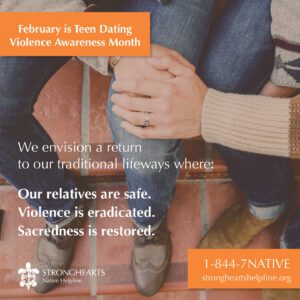February is Teen Dating Violence Awareness Month
February is Teen Dating Violence Awareness month
By StrongHearts Native Helpline
In February, Teen Dating Violence Awareness Month raises awareness for the unique needs Indigenous youth have and the impact healthy relationships can have for Native communities moving forward.
While one-quarter of all high school girls have been victims of physical or sexual abuse, a 1992 Minnesota youth study found that 92% of American Indian girls who reported having sexual intercourse have been forced against their will. Native American youth from 10-24 years old also make up 64% of suicides that happen in Native communities. Until we address the frequent occurrence and tremendous impact of Teen Dating Violence in Native populations, communities won’t be able to heal from the individual grief and collective trauma.
The first step of addressing Teen Dating Violence is understanding what dating violence is. Dating violence, another term for domestic violence, stems from a desire to gain and maintain power and control over a partner. An abusive partner may think they have the right to control and tell their partners what to do or how to behave. They may also feel a right to power over their partner.
Teen Dating Violence is abuse that takes place between teenagers and between young adults. Nationwide, almost 1 in 10 teens reports being physically abused by a boyfriend or girlfriend in the last year.
Abuse and dating violence are chosen behaviors. Sometimes we see abuse within our own families and communities growing up. More than 40% of children experience two or more acts of violence by the age of 18. We must not ignore that violence does happen within our communities, and oftentimes we feel ashamed to talk about it openly and honestly. Though we know it can be painful and uncomfortable to talk about, it’s important to acknowledge the experiences of dating violence and abuse so that we can begin honest conversations with young people early. This will help empower teens to speak up while alleviating feelings of shame and guilt.
We encourage parents and grandparents to talk with their teens and youth about the difference between healthy relationships and abusive ones. It’s always a great time to start having these conversations, no matter what age. Establish the lines of communications early. That way, children will know they can talk to you before something happens, not after.
Teen dating violence can involve one or more types of abuse, such as:
- Physical abuse: It can include slapping, kicking, strangling or punching, threats of violence or throwing items.
- Emotional Abuse: Some abusive partners may use emotional abuse to hurt their partners. This can include name-calling or using slurs or hurtful stereotypes to put you down. Emotional abuse can include when a dating partner isolates you from family or friends or makes all of the decisions in the relationship. They may even blame you for their abusive behavior or deny it completely, a tactic called gaslighting.
- Cultural/Spiritual Abuse: Cultural and spiritual abuse can be some of the most harmful forms of dating violence. This can look like when a romantic partner criticizes or punishes you for your cultural traditions or beliefs, tells you that you’re “too Indian” or “not Native enough,” or makes jokes about your blood quantum or tribe.
- Sexual Abuse: Some abusive relationships can include sexual abuse. This can look like when your partner pressures you to have sex or demands that you share sexually explicit photos or videos with them. Anytime a dating partner forces or coerces you into sexual activities without your consent, that is sexual assault, and it is never okay.
- Digital Abuse: In some relationships, social media is being used to hurt dating partners online. The signs of digital abuse can include when a partner tags you in humiliating photos, reveals private or embarrassing information about you, or tracks where you go and what you do online. Some abusive partners may even tell you who you can or cannot be friends with on Facebook or other accounts, or demand to know your social media or phone passwords. An abusive partner may also use their cell phones to repeatedly call, text, or leave messages just to “check-in” – all of which are types of digital abuse.
The impacts of dating violence on teenagers are widespread and will last until addressed and healed. Nearly 1.5 million high school students nationwide experience physical abuse from a dating partner each year. Perpetuating dating violence is a choice and StrongHearts advocates are available to help survivors as well as help address unhealthy behaviors with those concerned about their own actions.
When you are in an abusive relationship, you may find yourself feeling anxious, depressed, fearful, guilty or ashamed. You may even begin to believe you have done something to deserve the abuse. Dating violence is never okay. You deserve to always feel safe and respected in your relationship. It is also important to remember that you always have the strength of your ancestors behind you. You are sacred. You deserve a healthy relationship, where you feel safe and loved.
On Thursday, Feb. 10, starting at 10 a.m. CT, join StrongHearts Native Helpline on Twitter. A Native American dating violence survivor will be sharing their story throughout the day.
The post February is Teen Dating Violence Awareness Month first appeared on Native Sun News Today.

